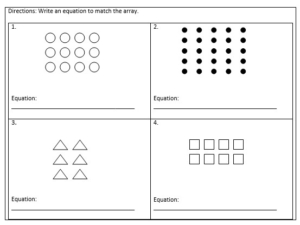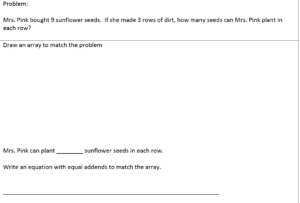MAFS.2.OA.3.4 Use addition to find the total number of objects arranged in rectangular arrays with up to 5 rows and up to 5 columns; write an equation to express the total as a sum of equal addends.
Cognitive Complexity Level: 1-Recall
[divider] [/divider] Students are able to…
- Identify the number of rows, columns, and total objects in a given array.
- Create arrays given a certain number of objects and express the total number in a repeated addition equation.
- Create an array given the dimensions (i.e. 2 rows 4 columns) and explain how to find the total amount (counting, skip counting, repeated addition).
[divider] [/divider] Students are able to…because teachers:
- Engage students in figuring out the total number of objects in various concrete and pictorial arrays.
- Pose questions to elicit precise descriptions of arrays (__rows ___ columns).
- Challenge students to create different arrays using a set amount of tiles or cubes and record descriptions as repeated addition equations.
[divider] [/divider] Questions to ask students:
- Ask: Point to an array and ask how many are there total? Explain how you know.
- Sample answer that indicates understanding: “The array has ___ I know because I skip counted by ___.”
- Ask: Give students 16 tiles and ask them to make an array. Then ask them to write an equation to match the array.
- Sample answer that indicates understanding: 1 row 16 columns; 16 rows 1 column;
4 rows 4 columns; 2 rows 8 columns; 8 rows 2 columns
Sample equations: 4 + 4 + 4 + 4 = 16 2+ 2+ 2+ 2+ 2 +2 +2 +2= 16 8 + 8 = 16
- Sample answer that indicates understanding: 1 row 16 columns; 16 rows 1 column;
[divider] [/divider] Additional Resources:
Additional in depth content knowledge
Video: Use repeated addition to find the total number of objects in an array
[divider] [/divider] Sample Formative Assessment Tasks:
[divider] [/divider] Resources/Tasks to Support Your Child at Home:
- The array game. Using a dice (with the 6 marked out), have your child roll two numbers. The first number will represent the number of rows in the rectangular array. The second number will represent the number of circles/squares/etc in each row. Have your child create or stamp the model. Then have them extend to record an equation that relates. (For example: If your child rolls a 4 and 3, they would make a rectangular array with 4 rows and 3 in each row. The equation would be 3+3+3+3=12).
- Khan Academy: Repeated Addition
- Youtube: Repeated Addition with Arrays

